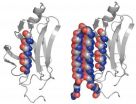(Press-News.org) Tropical Storm Hernan developed over this past weekend and reached hurricane strength before vertical wind shear kicked in and kicked the storm down. NASA's Terra satellite passed over Hernan when it was developing as a tropical depression near Baja California, Mexico.
Tropical Storm Hernan was born on Saturday, July 26 at 5 a.m. EDT as Tropical Depression 8-E. By 5 p.m. EDT it strengthened into Tropical Storm Hernan. At 11 a.m. EDT on Sunday, July 27, Hernan's maximum sustained winds were already up to 70 mph, just four miles per hour shy of hurricane status. As Hernan passed west of Socorro Island at 5 p.m. EDT on July 28 it reached hurricane status when its maximum sustained winds reached 75 mph (120 kph). It remained a hurricane for about 12 hours before dropping back to a tropical storm on July 29 at 5 a.m. EDT when maximum sustained winds were near 70 mph (110 kph).
Hernan moved into an area of persistent westerly wind shear blowing at between 15 to 20 knots (17.2 to 23.0 mph/27.8 to 37.0 kph). That wind shear is deteriorating the cyclone's organization. Infrared satellite data from instruments like the Atmospheric Infrared Sounder (AIRS) aboard NASA's Aqua satellite showed that the cloud top temperatures were warming. Warming cloud tops means that the uplift of air had weakened. Uplift is air that pushes thunderstorms into the top of the troposphere. The higher the thunderstorm cloud top, the colder it is (because the troposphere cools as you go higher). Higher, colder cloud tops in thunderstorms mean stronger thunderstorms.
Visible satellite data today indicated "a rather shapeless cloud pattern," according to the National Hurricane Center. That means the circulation is less organized.
At 11 a.m. EDT (1500 UTC) on July 28, Tropical Storm Hernan's maximum sustained winds were down to 65 mph (100 kph). It was centered near 20.5 north latitude and 115.9 west longitude, about 420 miles west-southwest (675 km) of the southern tip of Baja California. Hernan is moving toward the northwest near 16 mph (26 kph) and is forecast to continue through Tuesday night, July 29, followed by a turn to the west.
Forecaster Roberts at the National Hurricane Center noted today, July 28 that in addition to being battered by wind shear, "an increasingly stable air mass and decreasing sea surface temperatures should ultimately weaken Hernan into a shallow post-tropical cyclone in 48 hours."
INFORMATION:
NASA sees Tropical Storm Hernan near Mexico's Baja California
2014-07-28
ELSE PRESS RELEASES FROM THIS DATE:
NOAA: 'Nuisance flooding' an increasing problem as coastal sea levels rise
2014-07-28
Eight of the top 10 U.S. cities that have seen an increase in so-called "nuisance flooding"--which causes such public inconveniences as frequent road closures, overwhelmed storm drains and compromised infrastructure--are on the East Coast, according to a new NOAA technical report.
This nuisance flooding, caused by rising sea levels, has increased on all three U.S. coasts, between 300 and 925 percent since the 1960s.
The report, Sea Level Rise and Nuisance Flood Frequency Changes around the United States, also finds Annapolis and Baltimore, Maryland, lead the list with ...
Fist-bumping beats germ-spreading handshake, study reports
2014-07-28
Washington, DC, July 28, 2014 – "Fist bumping" transmits significantly fewer bacteria than either handshaking or high-fiving, while still addressing the cultural expectation of hand-to-hand contact between patients and clinicians, according to a study published in the August issue of the American Journal of Infection Control, the official publication of the Association for Professionals in Infection Control and Epidemiology (APIC).
In this study from the Institute of Biological, Environmental, and Rural Sciences at Aberystwyth University in the United Kingdom, researchers ...
New pill regimens published in The Lancet cure hardest-to-treat hepatitis C patients
2014-07-28
SAN ANTONIO (July 28, 2014) -- Researchers from The University of Texas Health Science Center at San Antonio, the Texas Liver Institute and other institutions have identified a combination of pills that cures 9 of 10 hepatitis C patients.
The combination of the drugs sofosbuvir and simeprevir, with or without ribavirin, cured 93 percent of patients in 12 weeks, and was well tolerated by patients, according to the study published today in The Lancet.
National study conducted in the U.S.
Eric Lawitz, M.D., clinical professor in the School of Medicine at the UT Health ...
Wait, wait -- don't tell me the good news yet
2014-07-28
Set goal, work to achieve goal, attain goal and react accordingly — that's the script we write when we set our sights on an achievement.
But what happens when the script isn't followed, and you learn too soon that you will accomplish what you set out to do? New research from the University of Chicago Booth School of Business finds that the positive reaction one would have when succeeding is lessened if it doesn't follow the expected course.
In "Feeling Good at the Right Time: Why People Value Predictability in Goal Attainment," Ayelet Fishbach, a professor of behavioral ...
New protein structure could help treat Alzheimer's, related diseases
2014-07-28
There is no cure for Alzheimer's disease and other forms of dementia, but the research community is one step closer to finding treatment.
University of Washington bioengineers have a designed a peptide structure that can stop the harmful changes of the body's normal proteins into a state that's linked to widespread diseases such as Alzheimer's, Parkinson's, heart disease, Type 2 diabetes and Lou Gehrig's disease. The synthetic molecule blocks these proteins as they shift from their normal state into an abnormally folded form by targeting a toxic intermediate phase.
The ...
Green spaces found to increase birth weight -- Ben-Gurion U. researcher
2014-07-28
BEER-SHEVA, ISRAEL, July 28, 2014...Mothers who live near green spaces deliver babies with significantly higher birth weights, according to a new study, "Green Spaces and Adverse Pregnancy Outcomes" published in the journal, Occupational and Environmental Medicine.
A team of researchers from Israel and Spain, including Ben-Gurion University of the Negev (BGU), evaluated nearly 40,000 single live births from a registry birth cohort in Tel Aviv, Israel to determine the impact of green surroundings during pregnancy and birth outcomes.
"We found that that overall, an increase ...
Strategies identified to improve oral contraceptive success with obese women
2014-07-28
PORTLAND, Ore. – The findings of a new study suggest two ways to effectively address the problem that birth control pills may not work as well in obese women, compared to women of a normal body mass index.
Birth control pills are a one-size-fits-all method, researchers say, but as the population has increased in weight, concern has grown about how well the pill works for obese women. Studies have consistently found that obesity has a negative impact on drug levels in the body, which may in turn affect how well the pill prevents pregnancy.
"Birth control pills have ...
How sweet it is
2014-07-28
A powerful new tool that can help advance the genetic engineering of "fuel" crops for clean, green and renewable bioenergy, has been developed by researchers with the U.S. Department of Energy (DOE)'s Joint BioEnergy Institute (JBEI), a multi-institutional partnership led by Lawrence Berkeley National Laboratory (Berkeley Lab). The JBEI researchers have developed an assay that enables scientists to identify and characterize the function of nucleotide sugar transporters, critical components in the biosynthesis of plant cell walls.
"Our unique assay enabled us to analyze ...
Scissoring the lipids
2014-07-28
A new strategy which enables molecules to be disconnected essentially anywhere, even remote from functionality, is described by researchers from the University of Bristol in Nature Chemistry today. The method is now being developed to explore the possibility of creating a tuberculosis (TB) vaccine.
The organic synthesis strategy, developed by Professor Varinder Aggarwal and Dr Ramesh Rasappan in the School of Chemistry, involves a new method for combining smaller fragments together in which there is no obvious history in the product of their genesis.
The paper describes ...
Study helps compare risks of treatments for early esophageal cancer
2014-07-28
CHICAGO – A new study, published in the July, 2014, issue of the Journal of the National Cancer Institute by Northwestern Medicine® researchers, sheds new light on the risks associated with the growing popularity of endoscopic resection in the treatment of localized, early-stage esophageal cancer. Researchers found that the more traditional surgical resection, while more invasive, provided significantly better outcomes with an 87.6 percent five-year survival rate for patients than endoscopic resection, which had a 76 percent five-year survival rate. The study, "Treatment ...




